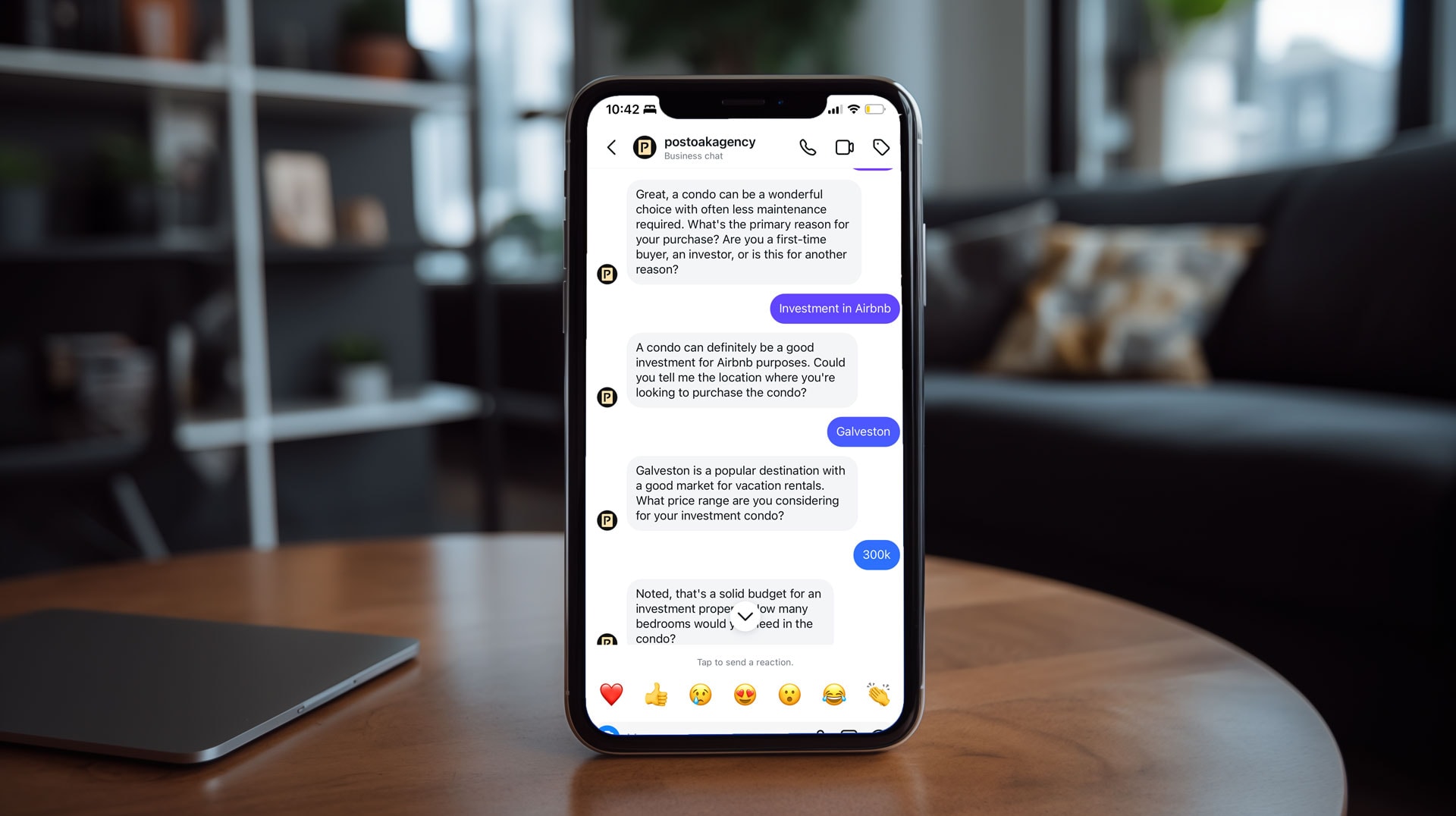How to Use a Chatbot for Real Estate Facebook Ads

9 min read
Chatbots have revolutionized the way businesses engage with their customers, and the real estate industry is no exception. In this article, we will explore how chatbots can be effectively utilized for real estate Facebook ads to streamline communication and enhance customer experience.
Understanding the Role of Chatbots in Real Estate
Chatbots, powered by artificial intelligence, are virtual assistants that can simulate human-like conversations with users. They provide instant responses to queries, automate tasks, and deliver personalized experiences. In real estate, chatbots can be used to answer common questions, provide property information, schedule appointments, and even assist in the buying and selling process.
Chatbots have revolutionized the way real estate agents and agencies interact with potential buyers and sellers. With their ability to handle multiple conversations simultaneously, chatbots have become an essential tool in the industry, providing efficient and effective customer service.
The Basics of Chatbots
Chatbots operate on predefined rules and algorithms that allow them to understand and respond to user inputs. They can be programmed to handle both simple and complex conversations, using natural language processing (NLP) to interpret and generate responses.
One of the key features of chatbots is their ability to learn and improve over time. By leveraging machine learning, chatbots continuously analyze user interactions and feedback to enhance their performance. This iterative process enables them to provide more accurate and relevant information with each conversation.
With advancements in technology, chatbots have become more sophisticated, incorporating sentiment analysis to understand the emotions and intentions behind user queries. This allows them to provide empathetic and personalized responses, creating a more human-like interaction.
Why Chatbots are Essential for Real Estate
Real estate transactions involve numerous inquiries, and chatbots provide a scalable solution to handle these queries efficiently. With their round-the-clock availability, chatbots can engage with potential buyers and sellers at any time, ensuring prompt responses and reducing the need for human intervention.
Moreover, chatbots can offer personalized experiences by analyzing user preferences and providing tailored property recommendations. By understanding the specific needs and requirements of each individual, chatbots can suggest properties that align with their preferences, saving time and effort for both the buyer and the agent.
In addition to assisting with property searches, chatbots can also streamline the buying and selling process. They can schedule appointments, collect necessary documents, and even facilitate negotiations between buyers and sellers. This automation not only saves time but also ensures a smoother and more efficient transaction.
Furthermore, chatbots can act as a valuable lead generation tool for real estate agents. By engaging with potential clients and capturing their contact information, chatbots can help agents expand their customer base and increase their chances of closing deals.
In conclusion, chatbots have become an integral part of the real estate industry, revolutionizing the way agents interact with clients. With their ability to provide instant responses, personalized experiences, and automate tasks, chatbots enhance efficiency, improve customer satisfaction, and ultimately drive success in the real estate market.
Setting Up Your Real Estate Chatbot
When implementing a chatbot for your real estate Facebook ads, it is essential to make the right choices throughout the setup process. Let's explore the key steps involved:
Setting up a chatbot for your real estate Facebook ads can greatly enhance your customer engagement and lead generation efforts. By automating responses to user inquiries, you can provide instant information and support, improving the overall user experience. However, to ensure the success of your chatbot, it is crucial to make informed decisions at every step of the setup process.
Choosing the Right Chatbot Platform
Selecting the appropriate chatbot platform is crucial as it determines the functionality and capabilities of your chatbot. There are several factors to consider when choosing a platform:
- Ease of Integration: Look for a platform that seamlessly integrates with your existing systems, such as your website or CRM software. This will ensure a smooth implementation process and minimize any disruptions to your workflow.
- Customization Options: Consider the level of customization offered by different platforms. You may want to personalize the chatbot's appearance, tone, and responses to align with your brand identity and customer preferences.
- Natural Language Processing (NLP) Capabilities: NLP allows the chatbot to understand and respond to user queries more effectively. Look for a platform that offers advanced NLP capabilities, such as sentiment analysis and entity recognition, to provide a more human-like conversation experience.
- Analytics: Analytics are essential for tracking the performance of your chatbot and identifying areas for improvement. Choose a platform that provides comprehensive analytics, such as user engagement metrics, conversation logs, and conversion rates.
By carefully considering these factors, you can select a chatbot platform that aligns with your objectives and budget.
Configuring Your Chatbot for Real Estate Queries
After selecting a platform, it's time to customize your chatbot to handle real estate-specific queries effectively. Here are some key steps to follow:
- Create a Knowledge Base: Build a comprehensive knowledge base that includes property listings, financing options, legal procedures, and frequently asked questions. This will ensure that your chatbot has access to accurate and up-to-date information to provide to users.
- Train the Chatbot: Train your chatbot to understand and respond to real estate-related queries. This involves feeding it with example questions and answers, allowing it to learn and improve over time. The more data you provide, the better your chatbot will become at handling various scenarios.
- Configure Responses: Set up your chatbot to provide accurate and detailed responses to user inquiries. This may involve integrating with your property management system to fetch real-time property information or connecting with a mortgage calculator API to provide instant financing estimates.
- Test and Refine: Before deploying your chatbot, thoroughly test its responses to ensure accuracy and relevance. Solicit feedback from real users and make necessary adjustments to improve the chatbot's performance.
By following these steps, you can configure your chatbot to effectively handle real estate queries and provide valuable information to potential customers.
Integrating Chatbot with Facebook Ads
Now that your chatbot is set up, it's time to integrate it with your Facebook ads for maximum effectiveness. By linking your chatbot to your Facebook account and optimizing your ads, you can create a seamless experience for your users. Let's dive into the details:
Linking Your Chatbot to Your Facebook Account
To link your chatbot to your Facebook account, you need to access the Facebook Messenger API. This API provides the necessary tools and instructions to integrate your chatbot with Facebook Messenger. By doing so, you enable users to directly interact with your chatbot through the messaging platform they are already familiar with.
Once you have accessed the Facebook Messenger API, you will find step-by-step instructions on how to connect your chatbot to your Facebook account. These instructions may involve creating a Facebook app, generating access tokens, and configuring webhook settings. It's essential to follow each step carefully to ensure a successful integration.
By linking your chatbot to your Facebook account, you open up a world of possibilities. Users can now engage with your chatbot, ask questions, seek information, and even make purchases, all within the familiar environment of Facebook Messenger.
Optimizing Your Facebook Ads for Chatbot Interactions
Once your chatbot is linked to your Facebook account, it's time to optimize your Facebook ads to encourage interaction with your chatbot. Crafting compelling ad copy is crucial in capturing users' attention and enticing them to engage with your chatbot for more information.
When creating your ad copy, focus on highlighting the unique value proposition of your chatbot. Explain how it can assist users, solve their problems, or provide valuable information. By clearly communicating the benefits of interacting with your chatbot, you can pique users' curiosity and encourage them to take action.
In addition to persuasive ad copy, including a clear call-to-action is essential. Your call-to-action should direct users to initiate a conversation with your chatbot. For example, you can use phrases like "Chat now," "Get started," or "Ask me anything" to prompt users to engage with your chatbot.
Remember to align your ad visuals with your ad copy and call-to-action. Use eye-catching images or videos that resonate with your target audience and complement the messaging of your ads. A cohesive and visually appealing ad will attract users' attention and increase the likelihood of them interacting with your chatbot.
By optimizing your Facebook ads for chatbot interactions, you create a seamless user journey. Users are enticed by your compelling ad copy, prompted to engage with your chatbot, and guided towards a conversation that can provide them with the information or assistance they need.
Integrating your chatbot with Facebook ads is a powerful strategy that can significantly enhance your marketing efforts. It allows you to leverage the popularity of Facebook Messenger and provide personalized, interactive experiences to your target audience. Follow the steps mentioned above, and you'll be on your way to maximizing the effectiveness of your chatbot and Facebook ads.
Strategies for Effective Chatbot Communication
Having a chatbot is only the first step; proper communication strategies are crucial for successful engagement with users. Here are some key strategies to consider:
Designing Engaging Conversations
Create conversational flows that are engaging and natural. Use a mix of open-ended and closed-ended questions to gather information from users and deliver relevant responses. Incorporate humor and personality where appropriate to make the conversation enjoyable for the user.
Providing Valuable Real Estate Information
In addition to answering queries, offer valuable real estate information to users. Share market trends, buying/selling tips, and insights into local neighborhoods. This positions you as a trusted source of information and establishes credibility with potential clients.
Measuring the Success of Your Chatbot
Measuring the impact of your chatbot is essential to optimize its performance and ensure it meets your business goals. Here's how you can assess its success:
Key Performance Indicators for Chatbots
Determine key performance indicators (KPIs) that align with your objectives. Track metrics such as response time, user satisfaction, lead generation, conversion rates, and cost savings. Analyze the data regularly to identify areas of improvement and make necessary adjustments.
Improving Your Chatbot Based on Feedback and Metrics
Take user feedback into account and continuously refine your chatbot. Identify recurring issues or limitations and address them to enhance user experience. Regularly update your chatbot's knowledge base to ensure it remains up-to-date with the latest market trends and property information.
By effectively utilizing chatbots in your real estate Facebook ads, you can streamline customer engagement, provide personalized experiences, and improve overall conversion rates. Embrace this evolving technology to stay ahead in the competitive real estate market.






